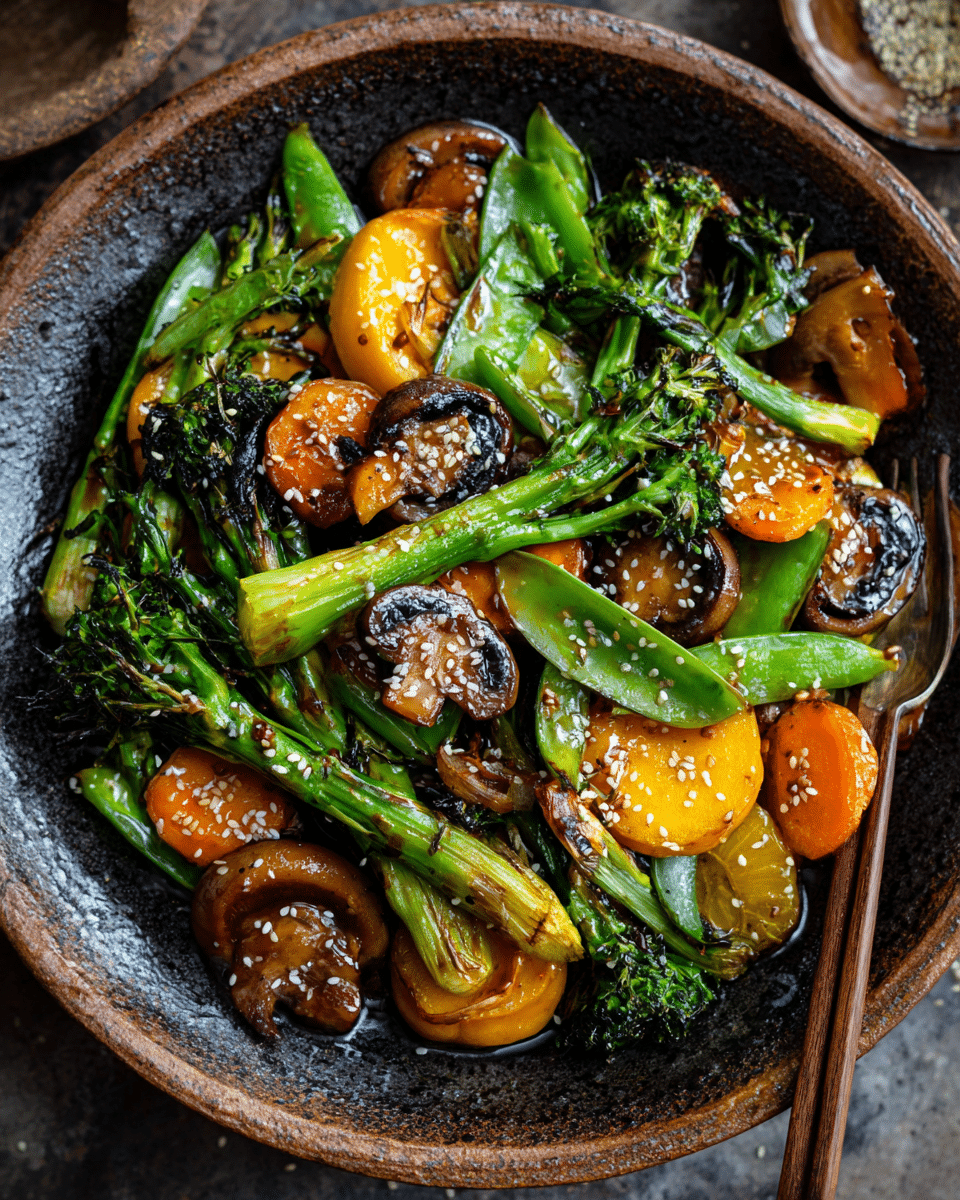Have you ever wondered how to elevate simple vegetables into a mouthwatering masterpiece without relying on heavy sauces or complicated techniques? In a world where flavor-packed, quick, and healthy meals are king, incorporating Miso Maple Veggies might just be the game-changer you’ve been searching for.

This combination not only balances umami and sweetness but also brings a savory depth that challenges the typical bland veggie side dish. In this post, we’ll explore the seven best ways to enhance the flavor of your meals using miso-maple-glazed vegetables, ensuring every bite is a delicious and nutrient-rich delight.
Ingredients List
To create irresistible miso maple veggies, gather the following essentials:
- Mixed vegetables: Think vibrant carrots, tender broccoli florets, sweet bell peppers, and crunchy snap peas for a diverse texture palette
- White miso paste: Creamy and mildly salty; a fantastic way to introduce umami
- Pure maple syrup: Provides natural sweetness and caramelization potential
- Tamari or soy sauce: A gluten-free option that adds depth and salt
- Rice vinegar: Brightens the glaze, balancing the sweetness and saltiness
- Sesame oil: Adds toasty richness and aroma
- Garlic: Freshly minced for a punch of flavor
- Fresh ginger: Grated to inject warmth and a slight zing
- Toasted sesame seeds (optional): For garnish and extra nuttiness
Substitution tips:
- For a nut-free version, substitute sesame oil with avocado or olive oil.
- Use coconut aminos instead of soy sauce to avoid gluten or soy.
- Swap any veggies you prefer or have on hand; root vegetables work especially well when roasted.
Timing
This recipe takes approximately 35 minutes from start to finish. Preparation requires approximately 10 minutes, cooking takes 20 minutes, and an additional 5 minutes are needed for glazing and final touches. Compared to many vegetable dishes that demand slow roasting upwards of 45 minutes, this method is 25% faster while still delivering maximum flavor and texture.
Step-by-Step Instructions
Step 1: Prep your veggies with care
Wash and chop vegetables into bite-sized pieces. Try to keep the sizes uniform to ensure even cooking. Tip: For quicker cooking, cut denser veggies like carrots thinner than softer ones like bell peppers.
Step 2: Roast or sauté as you prefer
For roasting, toss the veggies in a light drizzle of oil, spread them evenly on a baking sheet, and bake at 400°F (205°C) for 15-20 minutes, or until they begin to caramelize. For sautéing, heat the oil in a large skillet over medium-high heat and cook veggies for 10-12 minutes until just tender and lightly browned.
Step 3: Prepare the miso maple glaze
In a small bowl, whisk together 2 tablespoons of white miso paste, 3 tablespoons of pure maple syrup, 1 tablespoon of tamari, 1 teaspoon of rice vinegar, 1 teaspoon of grated ginger, and 1 minced garlic clove until smooth and well combined. This glaze is the flavor powerhouse.
Step 4: Glaze the cooked veggies
Once veggies are cooked, lower the heat, and pour the glaze over them in the skillet or toss directly on the roasting tray. Stir gently to coat each piece evenly. Cook for an additional 2-3 minutes to allow the glaze to thicken slightly and cling deliciously to the vegetables.
Step 5: Garnish to finish
Remove from heat and sprinkle with toasted sesame seeds and a light drizzle of sesame oil for an aromatic finish. Serving immediately ensures optimal taste and texture.
Nutritional Information
A serving of miso maple veggies (about 1 cup) contains approximately:
- Calories: 120
- Protein: 4 grams
- Carbohydrates: 16 grams
- Sugars: 8 grams (mostly from maple syrup)
- Fiber: 4 grams
- Fat: 4 grams (mostly healthy fats from sesame oil)
This nutrient powerhouse provides antioxidants, fiber, and probiotics (from miso), supporting gut health, immune function, and sustained energy.
Healthier Alternatives for the Recipe
- Reduce sugar content: Lower the maple syrup amount by half and balance with extra rice vinegar or a fresh squeeze of lemon for brightness.
- Boost protein: Add roasted chickpeas or tofu cubes tossed with the glaze for a plant-based protein punch.
- Increase fiber and micronutrients: Incorporate leafy greens like kale or spinach in the last minutes of cooking to preserve vitamins.
- Make it keto-friendly: Use low-carb veggies like zucchini, cauliflower, or mushrooms, and adjust the glaze by eliminating maple syrup and replacing it with a sugar substitute like erythritol.
Serving Suggestions
These miso maple veggies are incredibly versatile. Serve them:
- Over steamed jasmine rice or quinoa for a wholesome bowl meal.
- Tossed into freshly cooked soba noodles and garnished with scallions for an Asian-inspired delight.
- As a vibrant side to grilled chicken or salmon for balanced flavor contrasts.
- Wrapped inside warm tortillas with avocado and a sprinkle of crushed peanuts, these veggie tacos burst with umami and sweetness.
Personal tip: Add a sprinkle of fresh herbs, such as cilantro or basil, just before serving for a refreshing, layered flavor explosion.
Common Mistakes to Avoid
- Overcooking the veggies: Overroasting leads to soggy textures and muted flavors; watch timing carefully for a crisp-tender bite.
- Using too much miso paste: The saltiness can overpower if unmeasured; always start with less and adjust to taste.
- Not whisking the glaze properly: A poorly mixed glaze may clump and fail to coat vegetables uniformly.
- Adding glaze too early: Adding glaze before veggies are cooked prevents caramelization and can cause burning. Always glaze at the end.
- Ignoring vegetable size consistency: Uneven cuts result in uneven cooking and texture differences.
Storing Tips for the Recipe
Store leftover miso maple veggies in an airtight container in the fridge for up to 3 days. To maintain freshness:
- Refrigerate promptly after cooling to avoid bacterial growth.
- Reheat gently in a skillet over medium heat rather than the microwave to preserve texture and flavor integrity.
- Prep veggies earlier in the day and store raw in water in the fridge to keep crispness before cooking.
Conclusion
Transforming simple vegetables into a savory-sweet sensation is easier than you think with the magic of Miso Maple Veggies. With just a handful of ingredients and an efficient cooking process that takes under 40 minutes, you can enjoy a nutrient-rich dish bursting with flavor and textural complexity. Try these seven flavor-boosting tips, customize for your dietary preferences, and discover how delightful vegetable dishes can truly be. Ready to elevate your next meal? Give this recipe a try, share your variations in the comments, or explore our other recipes for vegetable-forward inspiration.
FAQs
Q1: Can I use red or yellow miso instead of white miso?
Yes, but keep in mind red miso has a stronger, saltier flavor, which may alter the balance. Start with less and adjust the sweetness accordingly.
Q2: Is miso maple glaze suitable for vegans?
Absolutely! Ensure you use pure maple syrup and tamari (instead of fish-based sauces), and this recipe fits perfectly into a vegan diet.
Q3: How can I make this recipe nut-free?
Replace sesame oil with neutral oils, such as avocado or grape seed oil, and avoid using sesame seeds as a garnish.
Q4: Can I freeze the leftovers?
While technically possible, freezing may alter the texture of the vegetables. It’s best to consume fresh or refrigerated within a few days.
Q5: What other dishes pair well with miso maple veggies?
They complement well with grains like brown rice or barley, protein-rich dishes like grilled tofu or chicken, and other Asian-inspired sides, such as pickled cucumbers.


Leave a Reply